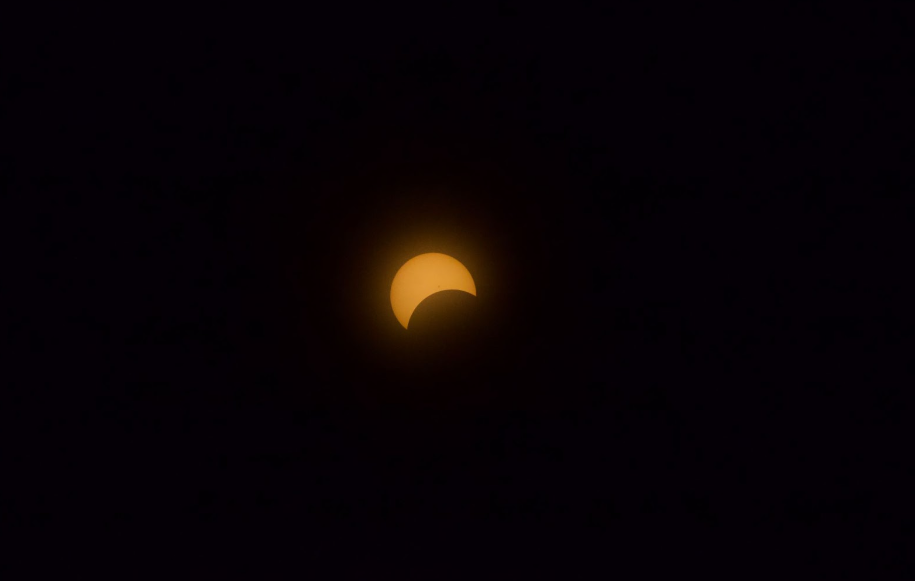The world slowly darkens as the moon draws in front of the sun, beads of light ring around the moon as the sun disappears beneath it. It is within this state that the most unnatural phenomena of the solar eclipse occur.
The Basics of a Solar Eclipse
A solar eclipse takes place when the Sun, Moon and Earth are in a specific linear position where the moon appears to cover the sun to viewers on Earth. During the recent solar eclipse on April 8, 2024, a narrow strip of land stretching from Texas to Maine experienced totality.
Totality, where the Moon completely covers the face of the Sun, is the maximum phase of the solar eclipse lasting from seconds to minutes. The area that experiences totality changes for each solar eclipse, influenced by the moon’s oscillating orbit around Earth and the tilt of Earth’s axis.
Juliette Becker, an assistant professor in the Astronomy Department at the University of Wisconsin-Madison, explained there were two aspects that are necessary to produce a solar eclipse. The first condition is that the size of the Moon is comparable to the size of the Sun so that light is blocked but not completely shielded from Earth. The second is that the Moon casts a shadow on the Earth by passing directly between the Earth and the Sun.
“Those two factors of geometry are actually quite lucky,” Becker said. “We don’t yet know of anywhere else in the universe that would experience eclipses in the way that we do here on Earth.”
Part of the mystique of the eclipse is in the scientific reasoning behind the eclipse. The phenomenon can be attributed to the diameter of the moon and the diameter of the sun that are proportional to the distance away from each other.
That’s why the moon covers up the whole sun, said Brian Culligan. “If the moon were a little bit closer, there would be a ring around it. If it were a little farther away, it would cover up everything, even the corona.”
Becker explained that the Moon’s relative position between the Earth and the Sun is changing over time. As the Moon moves away from Earth over thousands of years, it appears smaller in the sky. Eventually, it will not be able to cover the Sun completely–and totality will not occur.
“[In] around 500-600 million years, no one on Earth will be able to see a total Solar eclipse anymore, only annular eclipses […] when the Moon passes in front of the Sun […] but leaves a ring of sunlight around the edge,” Becker said.
Experiencing Totality
Both MHS teachers and students were enthusiastic about viewing the eclipse in totality, and many traveled to areas that were expected to be in the line of totality. Mary Blackmore, a Biology teacher at MHS, traveled to Marshall, Illinois to view totality, and likened the experience to the dim light of sunset, without the typical evening colors or long shadows.
“As the sun was getting covered, it became cooler and cooler…probably dropped by 10-15 degrees by totality,” Blackmore said. “Street lights came on and birds started singing like they do at dusk and dawn. I didn’t hear any owls, but some people I talked to from other locations did. [In] totality, you could see stars, Venus and Jupiter. We had binoculars, so we could make out the solar flares.”
Vasco Mangano, the president of MHS’s Astronomy club, also traveled to experience totality, and noted many of the same aspects that Blackmore did.
“Minutes before the eclipse, the sky gradually darkened, and then suddenly seemed to snap to become far darker as totality occurred.” Mangano said. “I was lucky to get four minutes of being able to look and take pictures of totality.”
Mangano continued to describe totality, saying that “the air became much cooler and the wind noticeably felt weaker. The solar eclipse appeared as […] a great black disc outlined by a ring of pure white, with faint rays of white seemingly spreading out from it.”
Although Culligan didn’t see the eclipse, he agreed that totality was not equivalent to seeing only a partial eclipse.
“Anything less than that is not quite as exciting,” Culligan said. “Where we saw it, it didn’t completely cover up the sun…I think people were expecting it to get darker, so seeing the full total eclipse is a lot more spectacular than seeing even 86 percent coverage.
Phenomena
The experience of a total solar eclipse is unique for many reasons, including the occurrence of different phenomena that are specific to the phase of totality. The cooler temperatures, solar flares and lower light intensities experienced by the teachers and students can all be attributed to characteristics of the eclipse.
Just before totality occurs, thin wavy lines of alternating light and dark can be seen moving on plain surfaces. This event, designated as shadow waves, was described for the first time in the 9th century CE, by English astronomer George B. Airy.
“‘As the totality approached, a strange fluctuation of light was seen upon the walls and the ground, so striking that in some places children ran after it and tried to catch it with their hands.,” Airy said of the 1842 solar eclipse.
The shadow waves are unpredictable between eclipses and seem to be related to the same phenomenon making stars twinkle, possibly in light or motion. The waves can also be viewed directly after totality.
Just before totality occurs, an effect known as the Diamond Ring Effect causes a burst of light on one edge of the moon and the sun’s corona (the outermost layer of the sun’s atmosphere), resembling a diamond ring. It appears for only about ten seconds, and decreases in intensity as totality comes into effect and the corona becomes more visible. This event takes place just before the appearance of Baily’s Beads.
Baily’s Beads is an array of spots resembling a string of beads seen directly before the moon covers the sun. This effect is caused by the mountains and valleys on the surface of the moon breaking up the narrow crescent of sunlight.
“[The valleys] will appear as little “beads” of light on the edge of the image, since the valleys are lower than the rest of the moon and so a little sunlight gets through,” Becker explained.
As the beads disappear and give way to totality, the eye’s sensitivity to luminance shifts from red to blue in low light. This is known as the Purkinje Effect, and is a result of the moon blocking direct sunlight from reaching Earth. This also limits solar radiation, causing the air to lose heat and decreasing the temperature.
In direct sunlight, however, red colors typically appear brighter as more red light reaches the ground. The light-gathering cells in the retina, called cones, are also tuned to detect red and green light along with a very small portion allocated for detection of blue light.
However, during the eclipse, the light reflecting off of objects is indirect light. As a result, objects reflect more blue light and the cones in the retina allocate a larger portion to blue light detection, causing the color spectrum shift.
In addition to the changes in color, the corona of the sun becomes much more visible during totality as the moon blocks out the bright light at the center of the Sun. The corona is approximately ten million times less dense than the surface–which decreases the brightness of the corona.
Despite its low density, the corona has very high temperatures. These temperatures are thought to be from hot material packets–sometimes called “heat bombs”–that travel into the corona from the sun and release their energy as heat, causing the high temperatures.
In addition to the higher temperatures on the Sun, its magnetic field is also much stronger than the one on Earth. Sunspots–areas on the surface of the Sun where the magnetic field is approximately 2500 times stronger than the field on Earth–are one of these phenomenons.
They can be seen during the time when the Moon is beginning to eclipse the Sun, explained Culligan.
“Many observers may have reported seeing a red dot of sorts during the eclipse, and I was able to capture it on my camera,” Mangano said. “It was a solar prominence/filament, which is simply an powerful explosion of sorts from the sun, not a solar flare, which is instead a powerful burst of radiation.
Against the Sun’s corona, it is also possible to see a solar flare or prominence–a large, bright eruption of highly energetic particles around the corona.
“I think it is important to distinguish what exactly separates a flare and a prominence,” Mangano said. “A prominence stays connected to the sun and is effectively anchored, a flare fully disconnects from the sun and flies off into space.”
Culligan explained that a solar flare or prominence would look like “a bunch of material looped around there” but that the occurrences were hard to see with the naked eye.
“[You all] are probably going to be around in 2044 when the next one is nearby,” Culligan said. “I won’t be here, but at least you’ll have an opportunity to see it in twenty years, and that’s a good thing.









